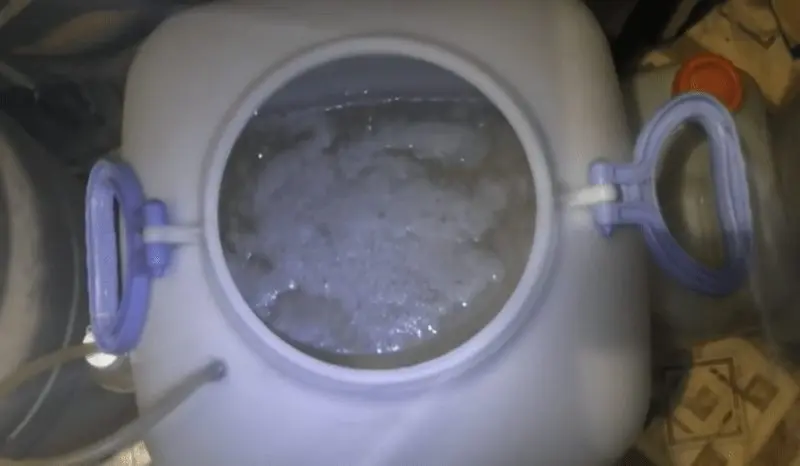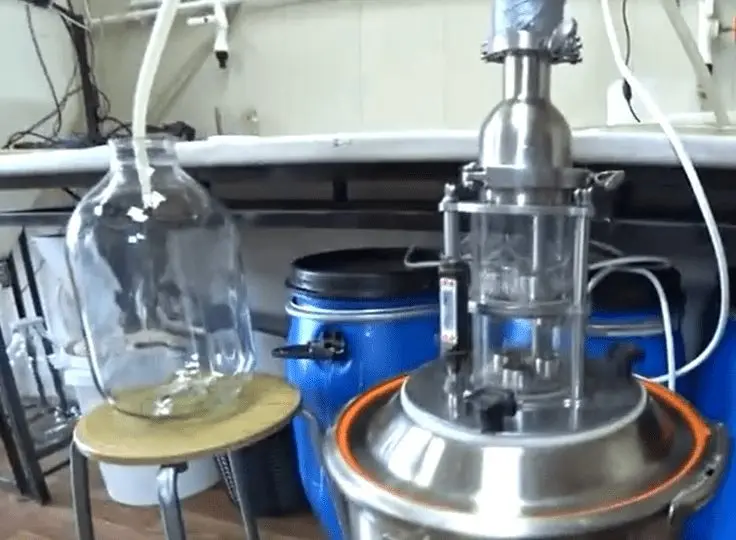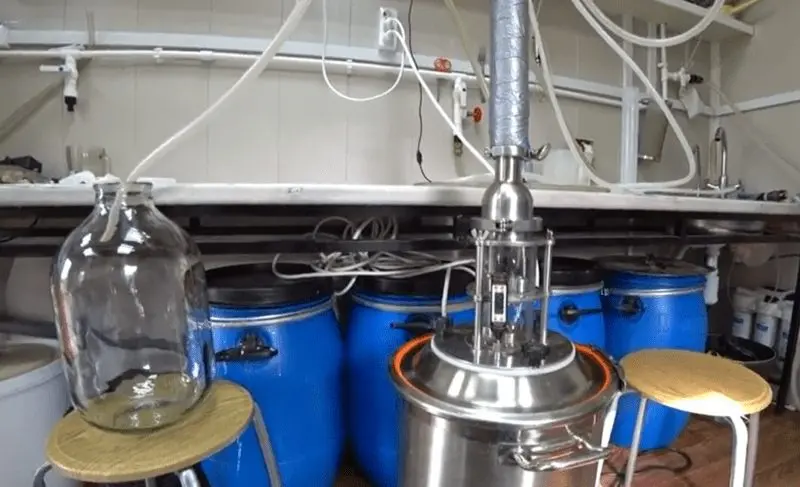Contents
Wheat moonshine is very soft, sweet and organoleptically superior to sugar distillate at times. But not everyone can work with starch-containing raw materials. Therefore, in this article you will find not only recipes with starch saccharification, but also an interesting recipe for wheat moonshine with sugar, without malt and enzymes.
Of course, not everyone can use grain as the main ingredient for making distillates. All these grouts, thermopauses, thick mashes, steam generators … BUT! If you have mastered the preparation of drinks from starch-containing raw materials, then endless possibilities and a whole world of unique distillates will open before you. Whiskey, bourbon, real vodka, a whole galaxy of “elites” based on grain alcohol. Is it worth starting acquaintance with wheat? It’s up to you, but it’s definitely worth a try.

So, in this article I have collected three completely different recipes. In the first we will use only wheat malt, in the second we will use wheat grain and barley malt to saccharify it, but in the third we will use regular sugar, but to give the drink a grainy character we will add wheat germ to the wort. Intrigued? Then without further ado, let’s get down to business!
Moonshine from wheat malt without sugar
Many moonshiners will tell you that only such a recipe is a true recipe for wheat moonshine (bread wine, polugar). Fortunately, we have already published a lot of materials on the preparation of distillates from starch-containing raw materials. For example, how to germinate wheat for moonshine is written in this article (it describes the process of germinating barley malt, but it is identical for wheat). In the last thematic article, namely in recipes for homemade whiskey, not only the process of malt saccharification itself is described, but also other secrets of making “water of life”.
Wheat n. “A grain that, if you put in the effort, makes a very tolerable whiskey. Also used for baking bread.
Ambrose Gwyneth Beers
I will not describe in detail the entire cooking process, but I will touch on the main aspects, including the technology for preparing green wheat malt:
- Rinse the grain until the debris disappears, and then soak: pour water 24-26оC, after 2-3 hours, change the water, and mix the grain, so repeat 3-4 times.
- We disinfect with manganese: pour the soaked grain with a solution of 1 g of manganese in 10 liters of water, wait 15-25 minutes until the color of potassium permanganate changes to brown.
- We wash the disinfected grain well under running water and spread it on any suitable surface (read the article on malt germination mentioned above) in an even layer 3-6 cm thick. We cover the grain with a damp sterile cloth from above.
- Every 12 hours we turn the grain, moisten the canvas, wring it out and return it to its place. We monitor the grain growth: when the sprout reaches a size of 1-3 mm, and the root is 7-12 mm, germination can be stopped.
Wheat grows much faster than barley and other crops (except rye). It usually takes about 24-48 hours for full germination. At the same time, the growth can be completed even earlier, when the root has reached a length of 3-5 mm, and the sprout is just pecking – the amount of enzymes in such malt is enough to saccharify itself. When the malt is ready, it must be disinfected again with manganese (second point), and then rinsed and allowed to drain. After that, it can be dried under the fan for a couple of hours and put into action.
So, you have germinated wheat and got green malt. It, as you remember, needs to be processed in 3 days, but after drying it at a temperature of up to 40оWith you get dry malt that can be stored for up to a year. It is better to boil malted milk from wheat malt in a steam boiler or a water bath so that the mash does not burn. Before this, of course, the malt must be ground using a meat grinder, blender, roller mill, etc.
It’s time to prepare the mash, sugar it and ferment it:
- For 1 kg of green or light malt we take 4 liters of water. We heat water up to 71оC and slowly pour in the malt, not forgetting to mix everything well. The main thing is that no lumps form. For these purposes, a drill with a nozzle for mixing paints, etc. is well suited.
- After pouring the malt and making sure that we got a homogeneous mass without lumps, we measure the temperature. We need to hit the pause 60-65оC. Insulate the brew kettle and maintain this temperature for 30-90 minutes. Every 10-15 minutes the wort must be actively mixed.
- After 30 minutes, you can begin to conduct an iodine test, but it is better to wait 60 minutes. Usually this time is enough for complete saccharification of the wort and this can be seen with the naked eye – its upper part should be significantly lightened. It’s time to cool the wort to 25-30оC for adding yeast.

- Cool the saccharified wort as quickly as possible. This is best done with a chiller, or by placing the kettle in an ice bath. When the temperature of the wort drops to 25-30оC, you need to add pre-prepared yeast to it (dry bakery needs 1-2 g per 1 kg of grist).
- The first day wanders very intensively, with abundant foaming. After 3-5 days, the mash can be distilled.
My thoughts and a link to the basics of fractional distillation can be found in the second recipe. It’s up to you to decide whether to filter the mash from grains or not, because it depends on your equipment (if you can distill it with steam, then it’s better not to strain, of course) and experience with thick mash. The resulting distillate can be left as is (polugar? bread wine? wheat whiskey?), you can insist on oak chips or pour into an oak barrel. On wheat moonshine from green malt, good tinctures should be obtained, for example, Borodino or something like that.
Recipe for moonshine made from wheat and barley malt without sugar

- 8,5 kg wheat (preferably spring)
- 1,5 kg barley malt (not fermented)
- 25 liter of clean water
- дрожжи
Preparation of wheat mash
Grind wheat and barley into fine grains (not flour). Heat water to 71оC in a large container. While stirring the already heated water, gradually pour in the crushed grain and malt, making sure that lumps do not form in the mash. You should get a homogeneous, fairly thick liquid. If necessary, bring the mash temperature up to 62-65оC (65оC ideally), this temperature should be maintained for 2 hours so that the malt enzymes completely convert the starch into sugar.
After a 2-hour pause, make an iodine test. The liquid itself should be significantly lighter. Sugared wort must be cooled very quickly to 25-27оWith a chiller or ice bath. Pour the cooled wort into a clean fermenter, filling it no more than ¾ of the total volume, since the grain mash is very foamy. If the farm has a hydrometer, it is advisable to measure the density. The ideal sugar content of the wort is 12-13% (1050). If the density is higher than this indicator, water must be added to the wort.
It’s time to add yeast. For this, ordinary dry or pressed baker’s yeast, as well as brewer’s yeast and Red Star champagne yeast are suitable. Dry bakery for our amount of mash is enough to take 30-35 g, pressed – 150-175 g, beer and champagne – according to the instructions on the package. Yeast, of course, must first be fermented. After adding yeast to the wort, a water seal must be installed on the fermenter. Fermentation should take place at a temperature of 28-30оC, it lasts an average of 4-5 days, but much depends on temperature, yeast strain and other other conditions.

Distillation of wheat mash
No innovation. We read the article about double distillation and do as it says. What follows is just my thoughts. Before distillation, we filter the wort through gauze or a sieve so that nothing burns in the cube (this is if there is no steam generator and experience in distilling thick mashes). We make the first stage as quickly as possible up to 10% alcohol in the stream without selecting heads and tails. Before the second distillation, we dilute the SS to 20-30%. Heads are selected 3-5% of the expected output of the AU, and it is better for the organoleptic distillate for smell. We finish the selection of the body with 50% alcohol in the stream. The tail fraction is either dry, or up to 20% in the stream – it is in the next first stage.
Dilute the resulting distillate to the desired strength and rest for 1-2 weeks (about 6 liters of 40% distillate are obtained from this amount of grain and malt). Wheat moonshine with saccharification with barley malt is sweet, easy to drink, does not require snacks. Barley malt endows it with a certain taste of whiskey with echoes of beer, so moonshine from wheat and barley malt is often insisted on oak chips and even poured into kegs. As an alternative way to process wheat mash: overtake it on a column and make high-quality vodka. I will talk about this some other time.

Moonshine from wheat (germs) and sugar
An old recipe, tested by hundreds of moonshiners over the hill. Wheat germ is sold in health food stores, etc. This is the core of a germinated grain without a hard protective shell, which contains a huge amount of nutrients necessary for plant growth. In terms of organoleptic properties, moonshine with the addition of wheat germ is significantly superior to ordinary sugar moonshine. In general, I recommend.

- 4,5 kg of sugar
- 500 g wheat germ
- 1 tsp citric acid*
- 1 pack of yeast**
* – instead of citric acid, you can take lemon or lime juice – 1 fruit should be enough.
** – beer and champagnes are suitable, as well as bakery in the proportion for sugar mash.
Place sugar, wheat germ and citric acid in a large saucepan (about 20 liters). Add water to bring the total volume of the mash to 19 liters, bring to a boil. Boil for 1-1,5 hours, then quickly cool to 27-30оC. Pour the wort into a fermentation tank with a volume of at least 30 liters, bring its volume with warm water to 22 liters. Add pre-fermented yeast, wait an hour, mix. Install a water seal. After a day, mix the mash again, install the water seal again and leave it alone until the end of fermentation in 3-4 days.
Strain the resulting mash through a sieve and pour into a distillation cube. The first distillation should be done up to 20-40% alcohol in the stream, the heads should be cut off at will. Raw alcohol is diluted to 20-30%, distilled fractionally, the heads are selected 3-5% of the expected AU. The body stop culling by 50-60%. Take the tail fraction up to 20% of alcohol in the stream – it is in the next shoulder strap. Dilute the resulting distillate to the desired strength and insist on oak chips.

Heads and tails can be collected in small portions, and then, by the organoleptic fractions, determine which of them will be appropriate in the body of the distillate, and which are best poured (heads) or added to the next distillation (tails).
I wish you good luck in your endeavors. In the next article I will tell you how to make wheat moonshine without yeast, or rather on wild wheat. It also turns out an interesting distillate with a sweet and very mild taste characteristic of wheat.









